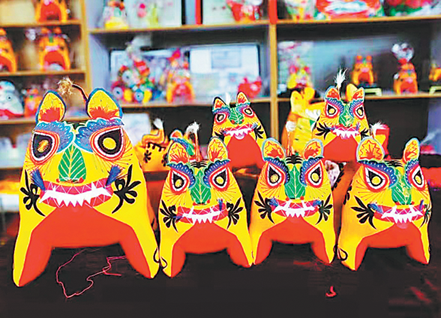Tiger toys winning fans from across the world

Lihou Tiger toys produced in Licheng come in chubby shapes and bright colors. [Photo by Liu Yan for China Daily]
When Spring Festival was celebrated earlier this month, cloth tiger toys produced in the Shanxi county of Licheng were sought-after nationwide, this year being the Year of the Tiger.
The toys made in the county are called Lihou Tigers, whose production technique was listed as a national intangible cultural heritage item in 2008.
The toy is so-called because Licheng used to be fief of Lihou, or marquis of Li, during the Shang (c.16th century-11th century BC) and Zhou (c.11th century-256 BC) dynasties, according to local researchers in history and culture.
Other researchers thought that the name of the toy is related to the township of Lihou, which is a major production base of Lihou Tigers.
But most of them agreed that the technique can be traced back to the Shang Dynasty, when locals regarded tigers as their totem.
The presumption was justified by local archaeological excavations. A great number of tiger-shaped utensils have been unearthed in various sites across the region, which have been identified as Shang Dynasty remains. According to historical records, the worship of tigers has continued for about 3,000 years.
The cloth tiger toys produced in Licheng are quite different from those made in other regions. A Lihou Tiger always has a chubby shape and bright colors.
In Licheng, as well as the rest of Shanxi, a tiger is a lucky animal for children, symbolizing strength, courage and health. It is a tradition during Spring Festival and other occasions like birthday celebrations to send cloth tiger toys to children as gifts, which is regarded as a show of best wishes.
For many centuries, Lihou Tigers had been popular in Licheng and neighboring areas, but little known in the rest of the country.
This changed in 1998, which again was the Year of the Tiger, when commemorative postage stamps were issued featuring varieties of Lihou Tigers. The cloth tiger toys were later exhibited in Beijing to celebrate the opening of the 2008 Olympic Games, drawing attention on the global stage.
Li Xiaomei, a provincial-level inheritor of the Lihou Tiger manufacturing technique, began to involve herself in the production and commercial promotion of the toy that year.
According to Li, Lihou Tiger manufacturing, with six procedures, is a combination of the arts of needlework, paper-cutting and embroidery.
Guo Lei, head of Licheng county's culture and tourism bureau, said the well-crafted Lihou Tiger toys are now gaining popularity in both domestic and overseas markets.
According to the official, there are more than 500 people in Licheng working in the production of Lihou Tiger toys.
Peng Ke'er contributed to this story.



